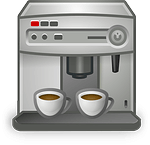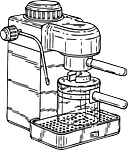
Pump Espresso Machine
Coffee lovers would agree that while getting a caffeine fix from your favorite coffee shop is great, nothing beats home brewed coffee. There is just something special about that hot drink you’ve made for yourself.
But how well do you know your home brew? Any self-proclaimed coffee lover should at least be familiar with the basics of the different types of coffee machines. The choice of machine used affects the preparation time and the taste of your drink. This article explains the basics of the most common types of coffee machines — the pump and steam espresso machines.
How Steam and Pump Espresso Machines Work
A Steam espresso machine is considered to be a starter coffeemaker. This type works by generating steam pressure by boiling water in a sealed chamber. Contrary to what most people think, espresso is not a term for a coffee bean but rather a process of extracting flavor from beans with the use of steam under pressure. Water in a reservoir is heated until it generates steam which is then forced under pressure through the coffee grinds. Steam espresso machines can generate around 3 bars of pressure.

Moka Pot
Two common types of steam models are countertop pressure units and stovetop boilers. An example of the latter, called Moka pots, are inexpensive two part espresso pots which are popular in Europe. Many coffee connoisseurs consider them inferior nowadays, however, because they produce a rather bitter type of coffee. Countertop pressure machines, on the other hand, are lightweight makers that come with steam wands to froth milk. This type is preferred over Moka pots because it creates a more tasteful flavor.
The Pump espresso machine is the second type of coffee maker and is commonly used in cafes and bars. It possesses what is called the Thermo-Block system which works by heating water for the espresso with the help of a radiator. Just like in steam machines, water is poured in a reservoir. Instead of heating the water in the reservoir, however, the water is converted to steam as it passes through the Thermo-Block coils. The steam is then forced through the grounds by machine pumping. Pump espresso machines are considered perfect for the true espresso lovers because of the flavorful and consistent coffee they produce.
The Differences between Steam and Pump Machines

Steam Espresso Machine
Because steam espresso machines use higher temperatures to create steam, they cannot produce what is called the crema or the golden brown foamy layer which is a characteristic of most espresso drinks. It is the layer that contains most of the flavor and can be produced with machines that have at least eight bars of pressure. As noted earlier, steam espresso machines can only manage around three. It is because of this that the flavor they produce sometimes seems to have a burnt taste.
Pump espresso machines, on the other hand, can produce 15 or more bars of pressure. The Thermo-Block system allows water to be heated to different temperatures for frothing and brewing. This function enables the production of crema and continuous steam needed for making lattes and cappuccinos.
Pros and Cons of the two types of Espresso Machines
Steam espresso machines are significantly more affordable than pump machines, and often make the perfect choice as gifts. They are good investments for those who are looking for starter espresso machines. Their disadvantage, however, is that they cannot produce crema and have a tendency of producing burnt tasting coffee. If not used properly, they can also be dangerous if the boiler cap or filter holder is removed prematurely — before the reservoir has cooled down and the pressure has returned to normal.
The advantage of pump espresso machines is that they can produce café quality espresso flavor complete with crema. Moreover, one does not need to wait for the machine to cool down before steaming and brewing again. Their greatest downside, however, is they are typically more expensive than the steam machines.
Originally posted 2014-02-06 22:34:50.